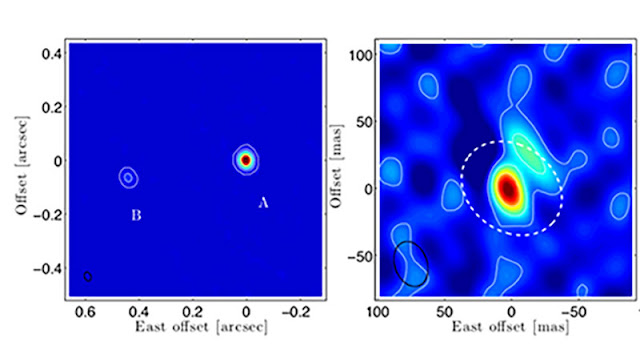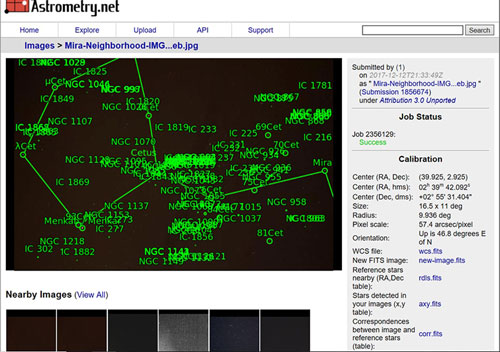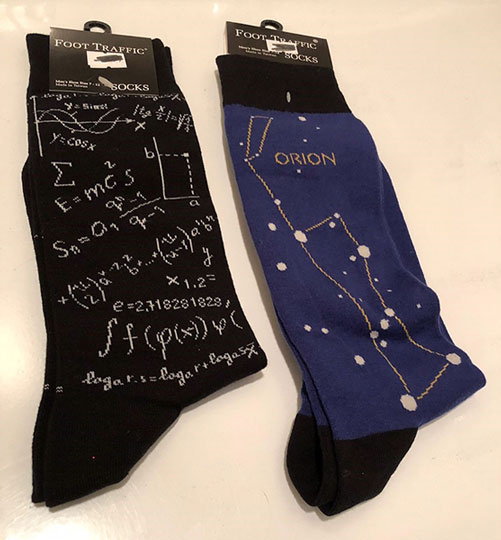Many astronomer hate when the clouds come in and interfere with our observations, but just looking up at the sky during the daytime can yield some interesting observations. We will talk about that in a minute and then we will discuss the wonderful star Mira and this lazy astronomers new approach to making quick observations of impossible to see in city lights and hard to find objects.
While out and about, escorting Astronomer Assistants Danny and Ruby, I noticed this view and image of some visible aircraft contrails. I wondered why the contrails didn't just evaporate away and instead developed these individual globs or lobes along the length of the contrail. What was going on?
 |
| Even on cloudy days astronomers look up and ask "Why do aircraft contrails form globules?" (Source: Palmia Observatory) |
What causes these lobes? See, you can also find curious things up in the day time sky! Make a guess and then check out this pretty good discussion regarding what is probably going on: http://onlinelibrary.wiley.com/doi/10.1002/wea.2765/full
At the monthly OCA meeting, the What's up Speaker, OCA and Griffiths Observatory Astronomer, Chris Butler, mentioned the wonderful star system, Mira. Mira is located in the constellation, Cetus, The Whale. Following astronomical star naming convention, Mira is identified as o Cet, for Omacron Cetus. I was so excited about Mira also, that I planned to make one of my own observations of the star. Thanks for generating the excitement, Chris!
Mira is currently understood to consist of a large red giant, designated Mira A, and a white dwarf, designated Mira B. Gas is being stripped from the red giant and flowing to the white dwarf and creating an enhanced accretion disk there. See the artist's concept image below.
 |
| Artists conception of binary red giant/ white dwarf with accretion disk (Source: www.aavso.org) |
 |
| Light curve measurements for Mira (Source: www.aavso.org) |
Light curve observation of Mira shows its wide magnitude change with a period of around one year. The observed magnitude varies between something like between dim 10 and quite bright 2. While it is harder to get high resolution optical images the use of long baseline radio astronomy can get resolved images down to the milli-arcsecond range. The ALMA images below show the relative distances between Mira A and Mira B and also a bright glob of gas around the red giant.
 |
| High resolution images of Mira A and B with ALMA (Source: Vlemmings, et al, arXiv:1503.07647v2) |
So, wow, Mira is quite wonderful and is the first of many prototypical star systems that exhibit much the same behavior.
I scheduled a quick observation of Mira and again used the lazy astronomer approach. Rather than wheel out the scope and rolling tripod, which by the way was put together to make it easy to do quick
observations, I felt even lazier and elected to just take out the camera tripod. The issue here then is how to find Mira when there are not a lot of visible stars nearby. Of course, if I wheeled out my tracking goto mount and did all the setup and alignment, I would be good to go, but that takes more work than I wanted to assign to this one simple light curve measurement data point.
So here is the lazy astronomer approach to this problem:
(1) Select a bright star, in this case Fomalhaut, near the target star, in this case, Mira
(2) Use planetarium software to calculate predicted Azimuth and Altitude of Fomalhaut at convenient observation time
(3) Use planetarium software to calculate predicted Azimuth and Altitude of Mira, say 5 minutes later
(4) Calculate the differences between the two values of Azimuth and Altitude
(5) Setup and level tripod and track reference star, Fomalhaut, up to the observation time
(6) Change tripod Azimuth and Altitude settings according to the calculated differences
(7) Wait until the chosen observation time for Mira
(8) Take the image and hope for the best.
The observation time for Fomalhaut was selected for 6:00 PM and predicted locations were Az = 189 and Alt = 26. The observation time for Mira was selected to be 5 minutes later when Az = 126 and Alt = 38. The difference between these two pointing locations is -63 degrees in Azimuth and + 12 degrees in Altitude.
We are now ready to make the observation when the sun goes down. The image below shows the various setting circles on the camera tripod head. A key thing to remember to do when using this method is to level the tripod, using the installed bubble levels, when the tripod has been setup in the selected observing location, which is chosen so that both reference star and target star are visible. Al I have to do is note what the azimuth and altitude indicators show for the starting location, here to be Fomalhaut, and then turn the knobs to adjust for the relative differential change in position for where Mira will be in 5 minutes.
 |
Use three-axis camera tripod head to point to target sky position (Source: Palmia Observatory)
The 15-second exposure had several visible stars, even though hardly any were naked eye visible so in order to tell if Mira was in the camera frame of view, the image was uploaded to Astrometry.net and hey, luckily, Mira was just barely inside. I guess my change to the azimuth and altitude settings was off a bit but still just enough to capture the target star.
|
 |
| Astrometry screenshot shows location of Mira and 81 Cet (Source: Palmia Observatory) |
Below is the DSLR image, 15 second exposure, 75 mm lens, with annotated locations of Mira and a known star, 81 Cet, that will serve as the photometric reference star. We can now use measurements of the total light received from the reference star and Mira in order to calculate our estimate of the visual magnitude of variable Mira at this observation time.
 |
| Mira and selected comparison star 81 Cet, 15 seconds, 75 mm, IMG3382 (Source: Palmia Observatory) |
Ok, the preliminary photometry on this photo, using AIP4WIN, measured the total light from Mira and compared it to the light from the reference star, 81 Cet. The total pixel ADU sum for Mira was found to be 357,170 and 81 Cet was measured to be 192,643. With 15 second exposures we must always be alert to suturing the camera with bright objects, but in this case these two stars only had maximum pixel ADU values of 6401 ADU, so the exposure time was just right. Now the reference magnitude for 81 Cet is m = 5.65 is adjusted by the scaling factor for the difference in received light
by 2.5 * log (357,170 / 192,643 ) = 0.67. So the estimated magnitude of Mira is 5.65 - 0.67 = 4.98.
We should not interpret the two significant digits in the estimate to actually be significant to two decimal places because of all the other correction factors that need to be applied to magnitude measurements. For instance this estimate does not include corrections for light extinction due to altitude, even though in this case the altitudes of the two stars are both within a couple of degrees, and the vignetting effects, but luckily in this case, both stars are located near the edges of the image.
So, this has been a wonderful review and first attempt at imaging the wonderful binary star, Mira, which has been observed by other astronomers for over 400 years now. It is known now that the two stars in the binary system are about 70 AU apart, which from our perspective is about 0.6 arc seconds and the pair is located about 92 pc or about 302 light years away from us. It is so neat to see that with new radio observatories, like ALMA, we can resolve these two stars down to the milli-arc second and begin to see the workings of the binary star accretion disk and bright spots and hot gas blobs around the red giant.
One lesson learned during this trial observation was to always plan for known rotation of the stars during your site selection. The location I picked was initially fine, but since I had got setup about 15 minutes before the first observation of Fomalhaut, by the time the final observation and centering of the star at 6:00 PM came around, the star was just dipping into a nearby palm tree and would have been obscured if I had to wait another 5 minutes. I also fooled myself into believing that everything was going to be ok because I could see the star from my eyelevel, but when I dropped down to camera optical axis level, there was hardly any margin left.
Finally, I received an anniversary gift from Resident Astronomer Peggy, who I assume was in cahoots with OCA and Hughes Lab Manager, Becky, both of which were shopping in Julian, and found some socks that could be useful to the budding physicist wannabe, especially as a crib sheet for the dreaded physics class quiz or exam.
 |
| Crib sheet socks for your next physics test? (Photo Source: Palmia Observatory) |
Until next time
Resident Astronomer George
If you are interested in things astronomical or in astrophysics and cosmology
Check out this blog at www.palmiaobservatory.com

No comments:
Post a Comment